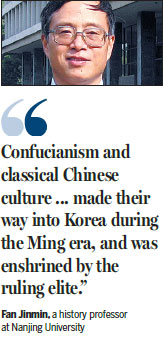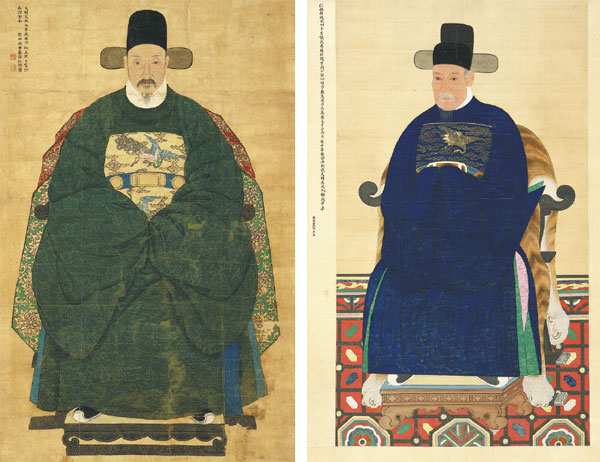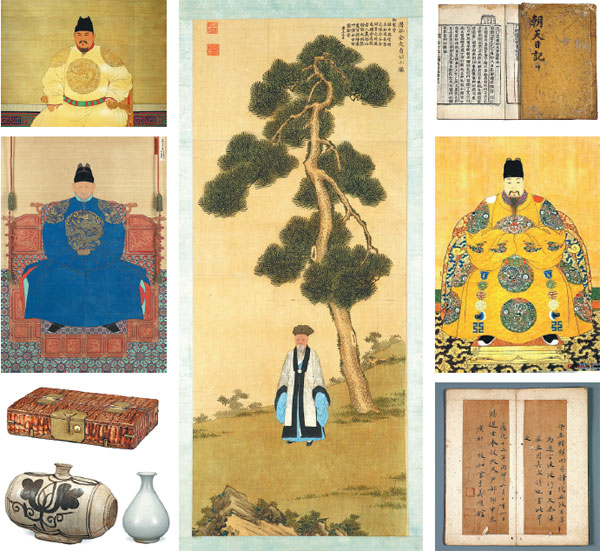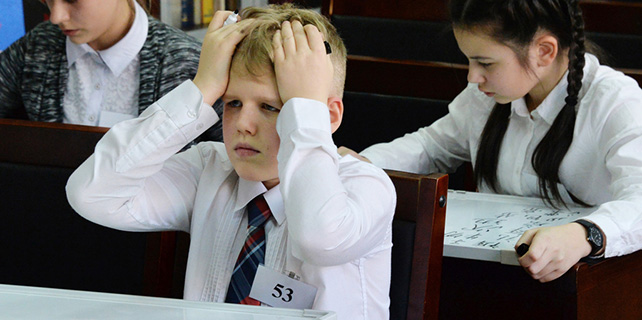Memories of respect etched by culture
Exhibition demonstrates the sway China had over Korea for centuries
Nam Yohong, the right-hand man to Korea's king Yi Jong, who lived in the first half of the 17th century, had his portrait painted twice by Chinese painters.
The first, in 1627, shows Nam as a benign-looking civil servant with a pair of baggy eyes that may have been the permanent residue of overwork or of the fierce power struggle that jolted the Korean court a few years earlier. (Four years earlier in 1623, Yi Jong rose to power by staging a military coup and deposing the king, his much-resented uncle Gwanghaegun. In the portrait, a tense and taut looking Nam appears to be still recovering from the aftershock of the event.)
The baggy eyes are still there in the second painting. But the gaunt feel has given way to a look of grim determination - a steely gaze and slight frown that betray an iron shrewdness. This was a man who had seen so much blood flow that eventually such violence would not make him flinch. It was painted in 1647, a year after Nam died aged 73.
Such emotional subtleties point to the tremendous skill of the portraitists - in Nam's case two. Both were court painters employed by the Chinese emperors to paint the Korean emissary while he was in Beijing. The city was the capital for the Ming Dynasty (1368-1644) and the succeeding Qing Dynasty (1644-1911).

Fan Jinmin, a history professor at Nanjing University, says the paintings and all other exhibits - about 300 pieces (sets) in total - that have been on view at the Zhejiang Provincial Museum testify to the deep devotion that China and Korea had for one another between the 14th and 17th centuries. In a sense, Nam witnessed the end of that relationship.
"During the time of Ming, Korea was China's vassal state," Fan says. "A Korean king would seek the approval of the Ming emperor if he wanted to banish his queen and marry a new one. When he died he would also be given a posthumous title by the Ming emperor. The influence was not played out merely on the court level. The Chinese lunar calendar, the ultimate time guide for an agricultural society, was widely used in Korea at the time."
Asked if the relationship was formed as a result of China's military and political might, Fan says such factors were certainly crucial. However, he emphasizes the cultural kinships that he says he believes lay at the heart of this prolonged period of mutual respect and admiration.
"Confucianism and classical Chinese culture, the version ordained by the Chinese rulers, made their way into Korea during the Ming era and was enshrined by the ruling elite. Those who wished to enter court service had to sit exams that tested their knowledge of Chinese literary and philosophical classics. Of course they wrote in Chinese."
Calligraphic works
In the exhibition you can gauge China's cultural influence over Korea from the calligraphic works of Koreans who lived between the 14th and 17th centuries. Many of these are in fact works of poetry penned during the process of what Ni Yi calls "literary diplomacy". Ni is the curator of an exhibition that tries to shed light on the Sino-Korean relationship during the Ming era by constructing a narrative line surrounding Choe Bu, a 15th-century Korean who had the bad luck to encounter strong wind at sea and the good luck to travel across China before returning to his native land.
"Given the frequency with which Korea sent its envoys to China - on occasions including the ascension to the throne of a new king, royal birthdays and funerals as well as important festivals - well-versed civil servants such as Nam were big assets to the Korean court," Ni says. "They also served as hosts to the Chinese envoy, often greatly impressing their guests, and in the process drew China and Korea even closer."
In the exhibition two beautifully made file cases are on display, one demonstrating a stunning natural grain of wood and the other showcasing the lacquer work of Korean craftsmen. Both were used to carry royal documents and letters.
More telling of the literary diplomacy are the ingeniously designed portable ink-and-brush holders. When inspiration hit, a poet could wait no more. Inspiration had presumably hit many times when a Chinese (or Korean) official was touring in foreign parts accompanied by his Korean (or Chinese) counterpart.
Given that most leading painters during the Ming era were literarily accomplished, it was only natural that the literary influences already mentioned seeped into the more broader area of aesthetics. (In 13th-century China and later, paintings by men of words were much celebrated and dubbed literati painting.)
Regrettably, few examples are on view in the exhibition, apart from portraits, one of which showed Kim Yuk, a Korean emissary, standing under a giant pine tree. It was done in 1659 by a Chinese painter named Hu Bing.
"Plein-air portraiture, which started to gain popularity during the Ming era, was also adopted by Korean artists of the time," Ni says. "The casual style of dress, complete with a jade pin to hold the flowing garment together, exudes a sense of leisure and calmness often associated with literati painting."
Political careers
The political careers of many Korean emissaries, Kim and Nam included, straddled two Chinese feudal dynasties, those of the Ming and Qing.
"The transition was in no way smooth," says Fan, the history professor. "For years the Ming Empire was at war with the Manchu, a nomadic group from northern China that later conquered all of China and set up their own empire known as Qing. There was fierce debate at the Korean court as to which side to support. But one thing seemed clear: siding with Qing was a pragmatic decision and siding with Ming was a moral one. At one stage, Korean soldiers were fighting Manchu troops alongside the Ming army."
Yet when the dust settled, the Korean kings had no choice but to be practical. Korea was still a vassal state of China under Qing, but certain things changed.
"The once strong emotional, cultural and spiritual ties once between China and Korea became tenuous," Fan says. "The Manchu rulers, members of a culturally less-sophisticated ethnic minority group, did not engender in the Koreans the same sense of admiration as their Ming predecessors once had."
Envoys were still sent to Beijing by the Korean court, but under different names. Earlier they had been called chao tian shi, or emissaries to the heavenly kingdom; during the Qing era they were reduced to yan xing shi, meaning emissaries to Beijing.
Reflecting on the phenomenon, Fan says: "Zhu Yuanzhang, the founding emperor of Ming, called Korea bu zheng zhi guo, a country that his empire would never try to lay her hands on. It was a drastic change of policy from the one adopted by the Mongols, whose rule Zhu had helped end. Under Mongol rule, Korea was taken as a Chinese prefecture. No wonder kings of Korea were grateful toward Ming."
Invasion
Between 1592 and 1598 Japan under Toyotomi Hideyoshi invaded Korea. The Ming Emperor Wanli twice sent troops to Korea to counter the Japanese, in 1593 and then in 1597 respectively, when his empire was being attacked by Mongols from the west. While the war ended with the sudden death of Toyotomi in 1598, the military help, which many Korean kings believed to have saved Korea from demise, was not forgotten.
In a telling show of nostalgia, Korean files from the Qing era are often dated using the reign title of the last Ming emperor, Emperor Chongzhen.
The exhibition includes a diary kept by Lee Heul, a Korean emissary to China, between July 8, 1629 and June 8, 1630. In 1899 the diary was reprinted in Korea. In the epilogue, it is noted that the reprinting was made in the 272nd year of the reign of Emperor Chongzhen, 255 years after the last Ming emperor hanged himself on a tree in his royal garden.
"Yi Seong-gye started the Joseon Dynasty in 1392, 24 years after the founding of Ming," Fans says. "The first thing the Korean king did was to ask for recognition from Zhu the first emperor of Ming. The Joseon Dynasty came to an end in 1910, one year after the fall of the Qing Dynasty in 1911. Both endings signaled the end of both countries' dynastic history. And both were to be followed by a chaotic, bloodstained era filled with struggles for personal freedom and national independence.
Lee died in Beijing on June 9, 1630 - one day after he finished writing his diary.
"In those days to be an emissary was not completely without risk," Ni says. "Nature could jeopardize the journey. Or, one could get seriously ill and die in a foreign land. But Lee, like most of his fellow emissaries to China, left behind writings that, together with other records, shed light on a shared memory in the two countries' history."
|
From left: Nam Yohong painted in 1627; Nam Yohong painted in 1706. Photos Provided To China Daily |
|
Clockwise from top left: Zhu Yuanzhang, the founding emperor of the Ming Dynasty; the portrait of Kim Yuk shows the senior Korean official standing under a giant pine tree; diary kept by Lee Heul, a Korean emissary to China who died in Beijing in 1630. The four big Chinese characters read chao tian ri ji, or Dairy of the Journey to the Heavenly Kingdom; Emperor Wanli of the Ming Dynasty; an example of literary diplomacy between Ming China and Joseon Korea-calligraphic works by Chinese and Korean emissaries; a white porcelain vase from 15th-16th century Korea; a porcelain pot from 15th-16th century Korea; a file case from Joseon Korea demonstrating the natural grain of wood; Yi Seong-gye (1335-1408), founder of the Korean Joseon Dynasty. |
(China Daily 02/11/2017 page14)


















